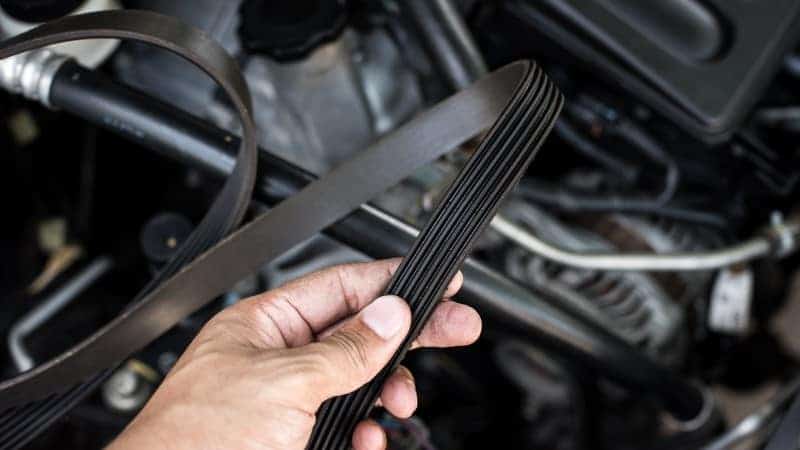Your car’s propulsion system consists of more than just the engine. A myriad of other parts need to work together for your car to go forward. One part of an automobile is the serpentine belt. If this often-overlooked but vital component breaks, your vehicle will stop dead in its tracks.
The performance of your vehicle can be negatively impacted if you are unaware of the symptoms of a damaged serpentine belt. “Does the serpentine belt affect the transmission?” you might ask. The answer is yes. Please continue reading this page if you would like to gain further information regarding serpentine belts.
Signs of a Bad Serpentine Belt

Your car is vulnerable to severe harm from a damaged serpentine belt. When a serpentine belt fails, what happens to the vehicle? Quite a bit. In the event that you notice any of the following symptoms, it is imperative that you address the issue with your serpentine belt without delay:
Sounds of Squeaking
When you hear noises near the front of your car, it could be an indication of a serpentine belt that needs replacing. If your serpentine belt is sliding and not properly set, this is a common sign. This might happen after washing the vehicle’s underside as well.
The screeching usually ceases after a while. But if you hear screeching noises coming from under the hood of your vehicle, it can be a sign that the belt has worn out. In this case, the vehicle’s high-pitched screeching sound becomes more audible as it climbs a hill. An unpleasant and difficult-to-ignore symptom of a serpentine belt tensioner.
Problems with steering
The functioning of the power steering system is ensured by the serpentine belt in vehicles equipped with Variable Assist Power Steering.
For the power steering pump to work as intended, the serpentine belt must provide the necessary power. Steering smoothly becomes a challenge when power steering is not available. Gaining control of the vehicle requires some practice with the steering.
Lack of Air Conditioning
When there’s an issue with the serpentine belt, your vehicle’s air conditioning will be affected because it powers the AC compressor. That doesn’t mean a broken serpentine belt is to blame every time the air conditioner turns on, but the vents don’t blow cold air. If this happens to you, the first thing you should do is check your serpentine belt.
When the Engine Gets Too Hot
By means of the water pump, the engine is cooled. An additional red flag is an engine that is overheating; this is because the serpentine belt is responsible for powering the water pump as well. The water pump is unable to circulate the water required to cool the engine in the event of a serpentine belt failure. If the water pump stops working, the engine will overheat and eventually break down.
Serpentine Belt Damage
If your serpentine belt is malfunctioning, this is one of the visible signs. It is necessary to replace the serpentine belt if it sustains any damage. A serpentine belt is strong and durable enough to run nonstop for a very long time. The belt will feel the effects of continuous running fatigue after a while. A serpentine belt will eventually wear out and snap.
This is seen on the belt in the form of rib wear, abrasions, fractured or broken ribs. For this reason, if you suspect that your serpentine belt is likely to give out, it’s best to check it out physically.
Sound of Whining
An issue with the serpentine belt can be present if you hear a whining noise that rises and falls in relation to the engine’s speed. Under excessive tension, the belt might damage the bearings of the pulleys that are attached to it. If you hear whining, it’s because the auxiliary pulley is too loaded. There is a problem with your serpentine belt if it makes even a single noise.
Not a Good Driving Experience
Because a broken serpentine belt reduces power, performance problems with your car can be an indication of a serpentine belt problem. Indeed, a distinct sign that diminishes your driving experience is an issue with the air conditioning, power steering, or an overheated engine.
You should inspect the serpentine belt if you encounter a cluster of problems such as a rough idle, flickering lights at engine startup, dimmed headlights, and trouble starting the vehicle, all of which typically indicate problems with the alternator. If you’ve been wondering if a damaged serpentine belt might produce rough idle, you’ve come to the right place. Yes, it is correct.
Conclusion
An extensive web of grooved rubber and metal, known as the serpentine belt, weaves its way around various engine accessories that draw power from it. For this reason, it performs a wide variety of tasks associated with the engine and the vehicle. Having said that, you definitely don’t want a broken serpentine belt in your car. A damaged serpentine belt poses serious risks to your safety and the engine and vehicle’s overall health.
Fortunately, a flawed serpentine belt will cause a number of symptoms. Knowing the signs of a serpentine belt problem will allow you to take action before the problem gets worse. Having a professional mechanic check the serpentine belt, belt tensioner, and other engine parts on a regular basis is your best choice.





